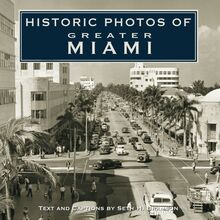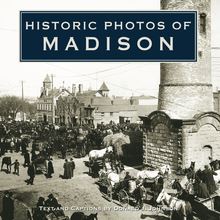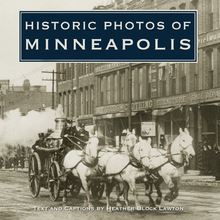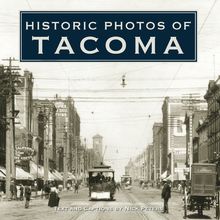Historic Photos of Denver in the 50s, 60s, and 70s , livre ebook
196
pages
English
Ebooks
2010
Vous pourrez modifier la taille du texte de cet ouvrage
Obtenez un accès à la bibliothèque pour le consulter en ligne En savoir plus
Découvre YouScribe en t'inscrivant gratuitement
Découvre YouScribe en t'inscrivant gratuitement
196
pages
English
Ebooks
2010
Vous pourrez modifier la taille du texte de cet ouvrage
Obtenez un accès à la bibliothèque pour le consulter en ligne En savoir plus
Publié par
Date de parution
28 juillet 2010
Nombre de lectures
1
EAN13
9781618583918
Langue
English
Poids de l'ouvrage
17 Mo
In the decades after World War II, the Mile High City traded its cowtown image for the glitter of skyscrapers, big-league sports teams, Interstate highways, and urbanity. As the Urban Renewal wrecking ball erased the city’s old skin and displaced some residents familiar with it, a new facade attracted Americans from far and wide in search of a Rocky Mountain way of life. Servicemen returning from the war came to build new businesses, and the next generation came just for the experience. The city could still take pride in the Brown Palace Hotel, the Daniels & Fisher Tower, the gold-domed State Capitol, and other emblems of its gold rush past, but its confidence in the future would give rise to ten new skyscrapers in one decade alone.
How Denver reinvented itself and came to have the appearance it displays today is a subject of more than passing interest. In Historic Photos of Denver in the 50s, 60s, and 70s, nearly 200 images reproduced in vivid black-and-white, with captions and introductions, tell a story familiar to the citizens of Denver who lived and reminisce about it and one that will fascinate newcomers curious to know more.
Publié par
Date de parution
28 juillet 2010
Nombre de lectures
1
EAN13
9781618583918
Langue
English
Poids de l'ouvrage
17 Mo
HISTORIC PHOTOS OF
DENVER
IN THE 50 S , 60 S , AND 70 S
T EXT AND C APTIONS BY M ICHAEL M ADIGAN
Mile High Stadium, home of the Denver Broncos professional football team, was given its new name and two new decks of seating on its west side in 1968. The new decks were necessary to increase seating to 50,000-one of the conditions of the American Football League franchise merging with the more prestigious National Football League. It was originally named Bears Stadium when it was constructed on a landfill in 1948.
HISTORIC PHOTOS OF
DENVER
IN THE 50 S , 60 S , AND 70 S
Turner Publishing Company
200 4th Avenue North Suite 950
Nashville, Tennessee 37219
(615) 255-2665
www.turnerpublishing.com
Historic Photos of Denver in the 50s, 60s, and 70s
Copyright 2010 Turner Publishing Company
All rights reserved.
This book or any part thereof may not be reproduced or transmitted in any form or by any means, electronic or mechanical, including photocopying, recording, or by any information storage and retrieval system, without permission in writing from the publisher.
Library of Congress Control Number: 2010921718
ISBN: 978-1-59652-595-5
Printed in China
10 11 12 13 14 15 16 17-0 9 8 7 6 5 4 3 2 1
C ONTENTS
A CKNOWLEDGMENTS
P REFACE
M AKING U P FOR L OST T IME (1950-1959)
G ROWING P AINS (1960-1969)
F ROM C OWTOWN TO THE B IG L EAGUES (1970-1979)
N OTES ON THE P HOTOGRAPHS
This rooftop view of the Cathedral of the Immaculate Conception s Gothic spires and the gold-plated dome of the State Capitol set against the backdrop of the Rockies was photographed June 26, 1974.
A CKNOWLEDGMENTS
This volume, Historic Photos of Denver in the 50s, 60s, and 70s , is the result of the cooperation and efforts of many individuals and organizations. It is with great thanks that we acknowledge the valuable contribution of the Library of Congress and the Denver Public Library, Western History Collection, for their generous support.
There is a treasure-neither hidden nor lost-on the fifth floor of the Denver Public Library in downtown Denver. Don t everyone rush there at once. It is the Western History/Genealogy Department s Western History Photograph Collection, and without it volumes like this one and others would never be published. The collection chronicles the people, events, and places that shaped the settlement and growth of the Western frontier. Most of the images you will find in this book were selected from this vast vault. The collection also includes a significant amount of material from the Colorado Historical Society photo collection. More than 120,000 images have been digitized and are available for viewing online at the library s Web site: www.history.denverlibrary.org . In addition, more than 600,000 undigitized photographs, negatives, cartes-de-visite, tintypes, albums, and stereocards exist in the Western History Photograph Collection, most of them dating from the nineteenth century. These can also be viewed by contacting the Western History/Genealogy staff.
The person who mothers this collection as personally as the photos in her wallet and who deserves the most credit for assisting with this project is Coi Drummond-Gehrig. Myron Vallier, a Web site librarian and author of a companion to this volume, Historic Photos of Denver (Turner Publishing, 2007), was of great help in identifying some Denver buildings. Ann Brown deserves thanks for her research expertise.
-------
To Molly, Sean, and Sophie, so that you may see a Denver you never knew, as if taken by the hand of the great-grandmother you never knew
P REFACE
I wish I had been a photographer. A good one.
It is one of several professions other than the one I chose as a writing journalist that, looking back, I think, I could have been that. Along with a seaman, an architect, a rancher. And, of course, a major-league first baseman; it s a left-handed calling. But of all these idle peeks at the rearview mirror, the one I m closest to and may have the most informed appreciation for is photographer. I think it is because I worked alongside some of the best in the business. The best in Denver. I listened in on their pre-assignment strategy sessions about where they would stand and what light they would steal. And I witnessed the magic arts of the photo editors who later picked just the right frame from a roll-yes, even in the 1970s they were film rolls-of thirty-six. Or one hundred and thirty-six. Some photographs taken by these professionals were selected for this retrospective from the archives of the Denver Public Library.
Most of the photographs, though, were chosen from private collections donated to DPL by six shooters-Charles S. Grover, Ralph Morgan, M. D. Smith, Fred Thumhart, Steve Weil, and Roger Whitacre. I do not know them personally. But it is evident they knew this city very personally and viewed it through the wide angle of experience. Many of the photographs have never been shared publicly, and might never have been. It is my privilege to see what they saw, and to document some of their life s work.
So why the 1950s, 1960s, and 1970s? It can be argued that modern Denver was defined in those thirty years after World War II. It also has to be one of the most complex periods in the city s history. It was a time when buildings began to scrape the sky. When historic landmarks were lost and brilliant new architecture discovered. When whole neighborhoods were relocated. When Beetles added to a growing air-pollution problem, and Beatles helped citizens forget their problems for one evening. When the city and state won and then forfeited one of the world s greatest spectacles, the Winter Olympics, in a period of two years. It was a time when all these things happened-for better and for worse-because people believed they were doing what was best for Denver. The book is naturally divided into three decades, one per chapter. Each one earned its own place in history, and in this book.
Not all of the photos are remarkable. But they are all honest. Except for touching up imperfections that have accrued with the passage of time and cropping where necessary, no other changes were made. The focus and clarity of some images is limited by the technology and the ability of the photographer, and by the environment at the instant he snapped the shutter.
I invite readers to scrutinize the photographs. To learn them. To discover the sign in the window, the future star at the bottom of the movie marquee, the street that no longer exists. There are secrets captured in each image.
That s why not everyone gets to be a photographer. A good one.
- Michael Madigan
Several well-known Denver landmarks can be picked out in this aerial photographed January 5, 1952. Starting clockwise from lower left: the City and County Building, the Auditorium-Theater, the Daniels Fisher Tower, the multi-columned Denver Post Office, and the State Capitol.
M AKING U P FOR L OST T IME
(1950-1959)
Denver and its residents emerged from World War II weary of its necessary limitations and sacrifices. The Queen City of the Plains was in desperate need of a makeover-civically, architecturally, culturally, and emotionally. It was a city in search of its identity.
It wasn t without a national image. But that image was based on the blessings of its geography on the flanks of the Rocky Mountains, pleasant though whimsical climate, and some venerable icons-the Brown Palace Hotel, the National Western Stock Show, and Elitch Gardens amusement park.
Change drove into town in fat-finned automobiles and parked in front of new clusterings of neighborhood stores-called malls -full of fresh goods and ideas. Federal tax-dollar funds fueled large public projects. To make room for the new growth, the Denver Urban Renewal Authority swept a huge broom-in the form of a wrecking ball-through blocks and blocks of downtown neighborhoods. Unfortunately, much history and heritage was swept away, too. Still, a building boom was begun that would last for three decades. The first skyscrapers changed the city skyline. Auto dealerships popped up seemingly overnight to supply the growing demand. The old-grid pattern of streets was modified with one-way streets. A toll highway was built between Denver and Boulder, and the first Interstate highway through the city-I-25, or the Valley Highway-opened.
Thousands of returning military men, whose families waited out the war at Lowry Air Force Base and Fort Logan and Rocky Mountain Arsenal, opened new businesses and created new jobs. Parks were expanded with new attractions for the swelling families. Radio and television, after a wartime glimpse of their potential, entered a period of huge expansion.
In 1959, the city awakened to learn it even had its own professional football team, the Denver Broncos of the fledgling American Football League, and it fell in love with a passion the rest of the country would come to envy.
The Mile High City now sounded a much more hopeful tone. Denver was on its way. It may have appeared sometimes it didn t know exactly where it was going. But it was making up for lost time.
A birds-eye view northwest takes in downtown Denver between 17th and 18th streets, including the Daniels Fisher Tower, center, one of the Mile High City s enduring landmarks. Building signs advertise the growing number of businesses and local attractions.
Stapleton Airfield, shown here in the early 1950s, was Denver s main airport over 66 years. It was known as Denver Municipal Airport when it opened in 1929. After an expansion in 1944, the name was changed to Stapleton Airfield in honor of Benjamin F. Stapleton, the city s mayor most of the years from 1923 to 1947. It later became Stapleton International Airport.
Old-style globe streetlights, traffic signals, and a grid of overhead electric trolley lines frame this view down 16th Street. The Daniels Fisher Tower anchors the west end with the Colorado State Bank on the corner. Years later, 16th St














